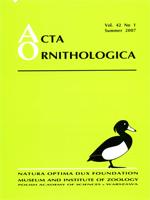The hunting ranges of 34 male urban Kestrels were studied in a small city (40 km2) in S Bohemia (Czech Republic). It was assumed that males from the city center and periphery hunt for voles mainly on the city's outskirts. The “city-center” males are unable to defend their hunting ranges on the periphery because of aggression on the part of the “periphery” Kestrels. To counter this, they may either 1) invade the hunting ranges of periphery males or 2) establish their own exclusive hunting ranges. Our data supported the first suggestion. Hunting range size varied greatly, from 0.8 to 25.0 km2 (7.2 ± 6.9 km2), with large overlaps of between 0.3% and 51.4% (12.5 ± 11.6%). The ranges of city-center males were several times larger than those of the periphery males, and greatly overlapped the ranges of other city center and periphery males. Overlapping of the hunting ranges of periphery males was less extensive. The higher energy costs in terms of flying to distant suitable hunting areas and frequent changes of hunting grounds should decrease the preference for nesting in the city center. Therefore, we suggest that Kestrels derive other advantages from living in the city center (e.g., the high quality of nest sites). Cohabitation, whereby city center males invade the hunting grounds of periphery males, appears to be a more effective strategy than partitioning.
How to translate text using browser tools
1 July 2007
How Urban Kestrels Falco tinnunculus Divide Their Hunting Grounds: Partitioning or Cohabitation?
Jan Riegert,
Drahomíra Fainová,
Václav Mikeŝ,
Roman Fuchs

Acta Ornithologica
Vol. 42 • No. 1
July 2007
Vol. 42 • No. 1
July 2007
Falco tinnunculus, urban
hunting range
Kestrel




